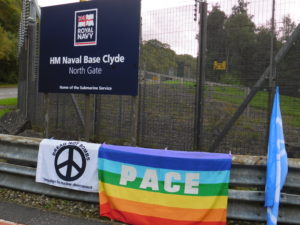Nuclear Subs and Rolls Royce’s Silver Bullet
Politicians everywhere seem to boundlessly attracted to hubristic grand projects, from the Pompidou Centre to HS2, and Boris Johnson seems to be particularly addicted to them, writes Sean Thompson on the Red Green Labour website.
His career has involved numerous doomed attempts to create a permanent monument to his greatness; Boris Island, the proposed new airport in the Thames estuary, the Boris Bridge One, over the Thames, Boris Bridge Two, between Scotland and the North of Ireland and, most ludicrously, the Boris Tunnel, between either Anglesey and Dublin or Stranraer and Larne. Now, his new great enthusiasm is for building nuclear power stations, announcing on 2 May that ‘Nuclear power stations…are absolutely crucial to weaning us off fossil fuels, including Russian oil and gas. Instead of a new one every decade, we’re going to build one every year’.
Clearly, not even even in Johnson’s most fevered moments of techno fantasy can even he imagine that such a wild promise could be fulfilled by building more behemoths (or is it dinosaurs?) such as that being built at Hinkley Point – estimated cost £18bn, actual cost £23bn and counting, and proposed for Sizewell – estimated cost £20bn, actual cost £?bn. The [UK] Government is desperate to find someone to take on construction of a new reactor at Wylfa on Anglesey but will have to come up with such a hugely generous deal to get it off the ground (if ever it does) that it’s unlikely that any more sites will even be proposed. In order to meet its proposed target of expanding nuclear power generation to provide 25% of Britain’s electricity capacity by 2050 (it’s currently at 16% and due to fall to 10% by 2030), Johnson’s government will have to rely on the successful development and rapid roll out of the SMRs (small modular reactors) being touted by Rolls Royce.
On the face of it, this might seem to be a good idea, since Rolls Royce has been producing small pressurised water reactors, to power submarines, at its Marine Operations plant in Derby since 1965. Rolls-Royce aims to build 16 SMRs, which it says would have a ‘target cost’ of £1.8bn each (as long as at least 5 are ordered simultaneously – so a sort of super BOGOF deal). Rolls Royce claim that the reactor itself will be ‘only’ about 16 metres by 4 metres, and thus able to be transported by road, rail or sea, although each plant will have an area of around five and half football pitches.
This all sounds like a very attractive option to those who look to nuclear energy as the silver – though hugely expensive, and radioactive – bullet that might allow for the continuation of business as usual in the face of global warming. However, Rolls Royce and Johnson are ignoring a number of inconvenient issues; so far, not one SMR has actually been manufactured and operated in the real world, the costs – like all large engineering projects using untried technology, will almost certainly be very much higher than estimated – and, like all other nuclear reactors, they will have a limited life before they must be decommissioned and even during their active lives they will produce highly toxic waste that must be safely disposed of.
Of course, the problems of safely dismantling and disposing of small nuclear reactors must surely have been sorted out by now, since Rolls Royce have been manufacturing small pressurised water reactors for nuclear submarines for 57 years? Unfortunately not.
Britain’s first nuclear submarine, HMS Dreadnought, launched in 1966 and decommissioned in 1980, has now been tied up in the naval dockyard at Rosyth [on the Forth Estuary in Scotland] far longer than she was in active service. In all, there are currently 21 former Royal Navy nuclear submarines awaiting disposal, 7 in Rosyth and 14 in Devonport, with another due to go out of service next year and five more to be scrapped by 2040.
The original plan was, like the USA and the USSR, to dispose of decommissioned nuclear subs by filling the them with concrete and sinking them in the deep ocean but thankfully the disposal of nuclear waste at sea was banned by the London Dumping Convention in 1983. By now more than £500M has been spent on submarine storage and maintenance since the Dreadnought was retired and the bill is going steadily up each year.
One of the reasons for the extraordinary delay in dealing with this ever growing pile of radioactive junk [much of it in Scotland – eds] is that, while in the civil nuclear industry, operators are required by law to put aside funds and make plans during the life of the plant to pay for decommissioning – which partly accounts for electricity generated by nuclear reactors being by far the most expensive energy source available – no such requirement was made of the MoD and successive [UK] governments failed to make arrangements for the timely disposal of these vessels.
Planning for the dismantling of these submarines should have been started at the time of the London Dumping Convention almost 40 years ago, but only in the last 10 years, as the space available for storing nuclear hulks steadily filled up (Rosyth is full and there is currently space for only one more at Devonport) has there been any serious effort to deal with the issue. As a result, in January Forces Net the MoD’s in-house PR website proudly announced a ‘world first’ – the MoD was going to start to cut up and dispose of its old nuclear submarines. According to the MoD the total disposal cost will be at least £3bn over 25 years and continue into the 2040s.
However this claim looks, to say the least, rather optimistic. In 2003 the facilities for de-fuelling were deemed no longer safe enough to meet modern regulation standards and the process was halted, meaning that 11 of the hulks are still full of uranium fuel rods. And even if or when the fuel rods can be removed, disposing of the 10% of the hulks that are classified as Intermediate Level Waste remains an unresolved problem.
Low-Level Waste from the hulks can be stored at Sellafield in vaults along with the huge amounts of radioactive detritus generated by Britain’s nuclear power stations, and, according to the Navy Lookout website, in 2017 a partly UK Government owned company, URENCO Nuclear Stewardship, was commissioned to provide an interim site at Capenhurst in Cheshire for the more dangerous intermediate level waste, which includes the Reactor Pressure Vessels removed from the submarines. The waste will be ‘temporarily’ stored in purpose-built buildings above ground but, according to the MoD PR handouts, will eventually be moved to a permanent underground ‘Geological Disposal Facility’, which will have to be built in the 2040s as by then the Capenhurst facility will be full. The only problem with this plan is that successive [UK] governments have failed to find a permanent disposal site – partly because identifying such a site has proved to be geologically extremely elusive but also because trying to locate it almost anywhere in the UK would be as politically toxic to its proponents as its proposed contents would be radiologically.
This Rolls Royce’s vaunted techno-fix runs up against the same intractable problem that has faced the nuclear energy industry since its inception; it produces toxic waste that must be securely stored for tens of thousands years, and and so far no one has found a way to safely and permanently do it.
Reproduced from Red Green Labour: https://redgreenlabour.org/2022/05/19/nuclear-subs-and-rolls-royces-silver-bullet/ 19 May 2022
[Photo above: One of four UK government nuclear-powered and nuclear-armed submarines, HMS Victorious, departs the Faslane naval base on the Clyde. Photo from Ministry of Defence via WikiCommons Open Government Licence.]

[Editorial note: This article was written for a Britain wide audience but there is a specific Scottish dimension that needs raising as well. The Scottish Government of the Scottish National Party (SNP), supported by the Scottish Green Party, is currently opposed to Boris Johnson and the UK government building any further nuclear (fission) power stations in Scotland, and under UK devolution laws has control over the planning system to prevent any being built. However, the UK government currently has control over the Faslane naval base on the Clyde and the four nuclear-powered submarines armed with the Trident nuclear missiles that are permanently based there. These submarines are due to be decommissioned and replaced, and as the article above shows the UK government controlled Rosyth naval base on the Forth has been used to store submarine based nuclear reactors no-longer used in active service. With Nicola Sturgeon in Washington this week recommitting a future independent Scotland to membership of the NATO military and nuclear alliance, and thereby the continuation of the nuclear weapons and nuclear powered submarines programme, concerns should be raised at how it is not possible to achieve a nuclear free Scotland under the SNP. Mike Picken for ecosocialist.scot. See also: Faslane Peace Camp 40th Anniversary 10-12 June 2022.]

